Finance & Operations Report: Evaluating New Life Training Plc Proposal
VerifiedAdded on 2021/06/16
|20
|5485
|41
Report
AI Summary
This report analyzes the financial performance of New Life Training Plc concerning a new business proposal. It evaluates operational and regulatory factors, estimates income and expenditure projections for the first four years, and assesses the financial worth of the proposal using investment appraisal techniques such as NPV, ARR, IRR, and payback period. The report also considers various sources of finance, including mortgages, share issues, and bank loans, as well as internal sources like sales of assets and retained profits. The analysis includes projected revenues and expenses, leading to a cash flow forecast and a discussion of potential profit generation. The conclusion provides recommendations to the board for improving profitability and operational efficiency. The report highlights the importance of operational management theory in optimizing costs and maximizing profits, with a focus on tutor fees and other overhead expenses.
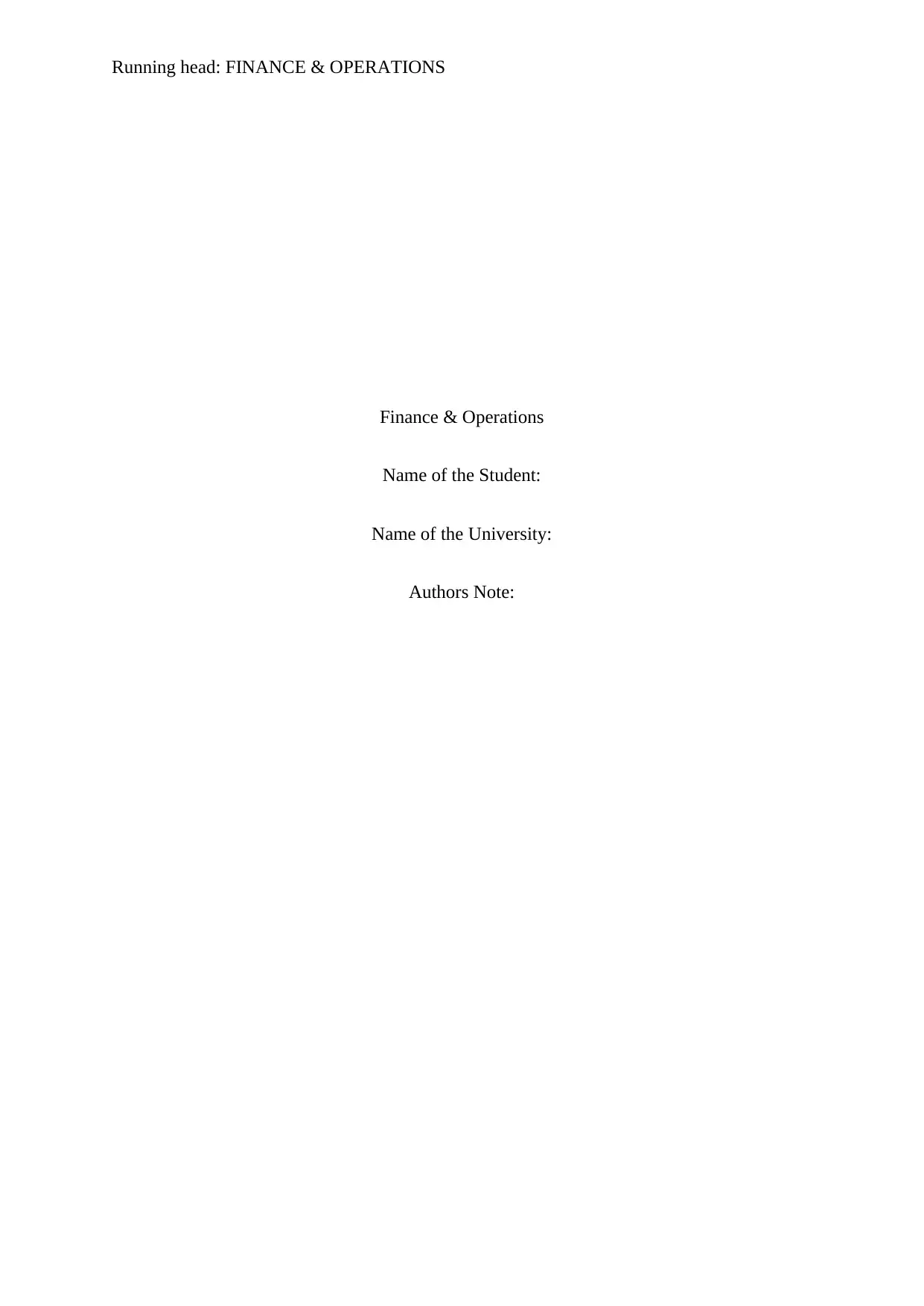
Running head: FINANCE & OPERATIONS
Finance & Operations
Name of the Student:
Name of the University:
Authors Note:
Finance & Operations
Name of the Student:
Name of the University:
Authors Note:
Paraphrase This Document
Need a fresh take? Get an instant paraphrase of this document with our AI Paraphraser
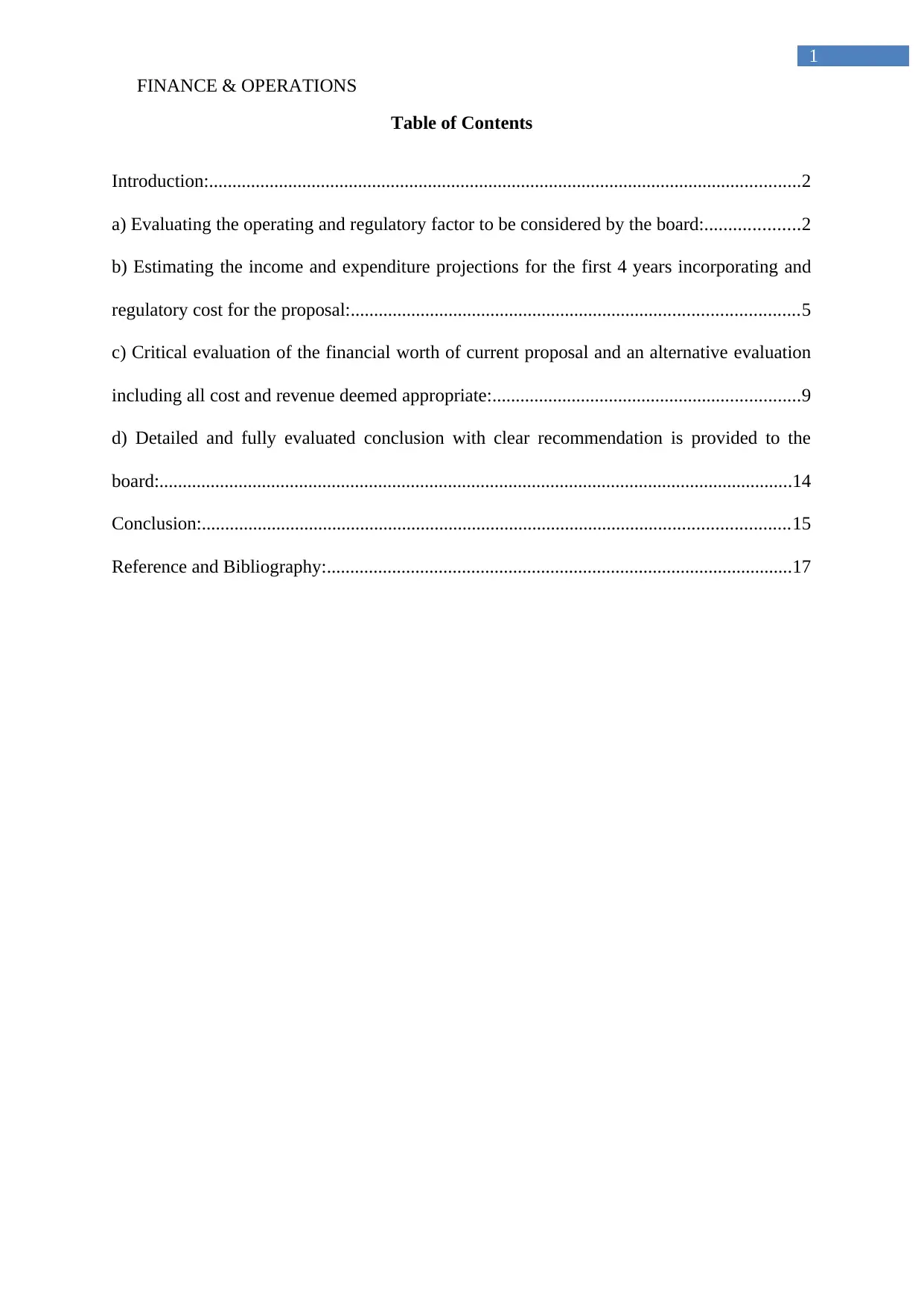
FINANCE & OPERATIONS
1
Table of Contents
Introduction:...............................................................................................................................2
a) Evaluating the operating and regulatory factor to be considered by the board:....................2
b) Estimating the income and expenditure projections for the first 4 years incorporating and
regulatory cost for the proposal:................................................................................................5
c) Critical evaluation of the financial worth of current proposal and an alternative evaluation
including all cost and revenue deemed appropriate:..................................................................9
d) Detailed and fully evaluated conclusion with clear recommendation is provided to the
board:........................................................................................................................................14
Conclusion:..............................................................................................................................15
Reference and Bibliography:....................................................................................................17
1
Table of Contents
Introduction:...............................................................................................................................2
a) Evaluating the operating and regulatory factor to be considered by the board:....................2
b) Estimating the income and expenditure projections for the first 4 years incorporating and
regulatory cost for the proposal:................................................................................................5
c) Critical evaluation of the financial worth of current proposal and an alternative evaluation
including all cost and revenue deemed appropriate:..................................................................9
d) Detailed and fully evaluated conclusion with clear recommendation is provided to the
board:........................................................................................................................................14
Conclusion:..............................................................................................................................15
Reference and Bibliography:....................................................................................................17
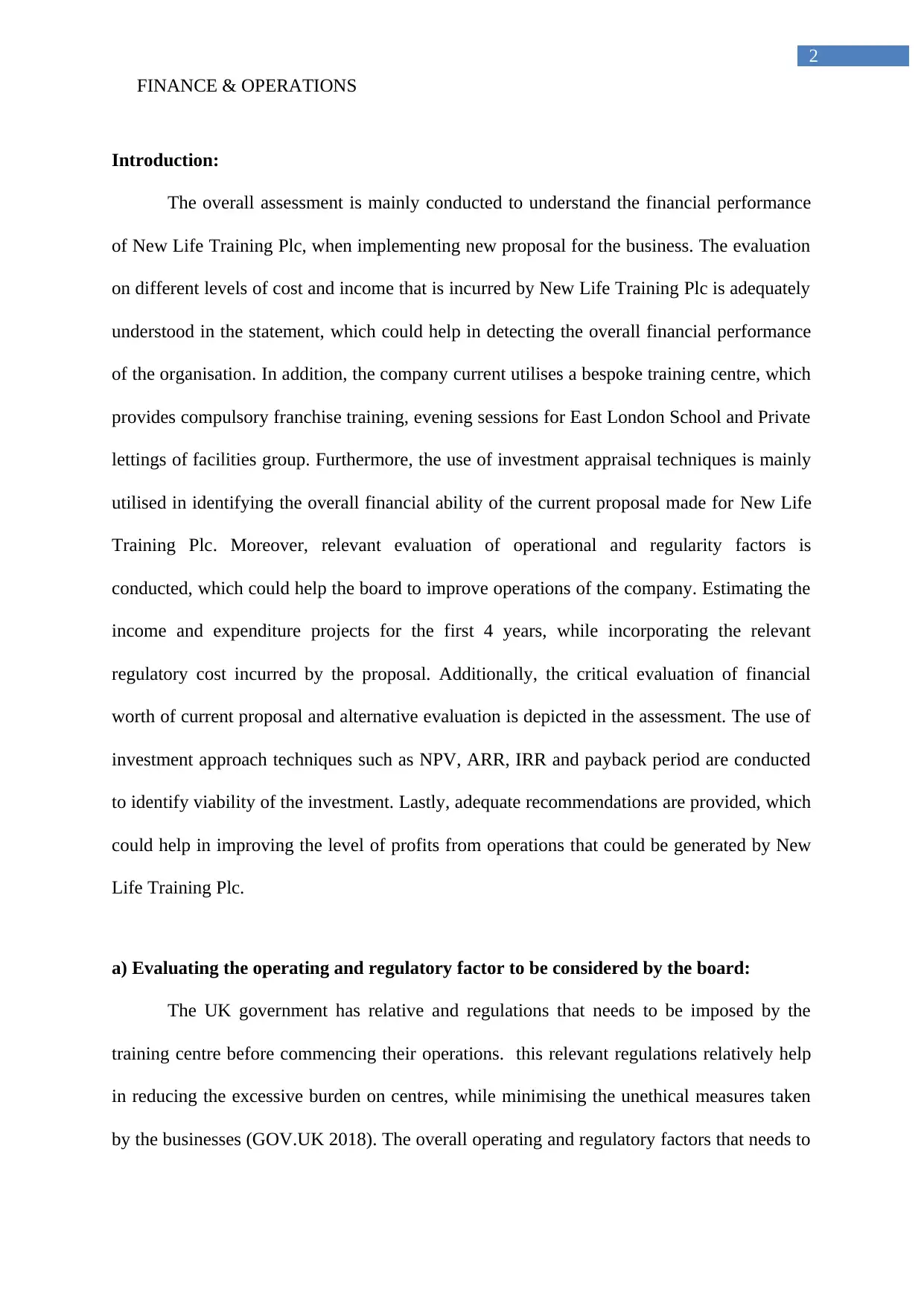
FINANCE & OPERATIONS
2
Introduction:
The overall assessment is mainly conducted to understand the financial performance
of New Life Training Plc, when implementing new proposal for the business. The evaluation
on different levels of cost and income that is incurred by New Life Training Plc is adequately
understood in the statement, which could help in detecting the overall financial performance
of the organisation. In addition, the company current utilises a bespoke training centre, which
provides compulsory franchise training, evening sessions for East London School and Private
lettings of facilities group. Furthermore, the use of investment appraisal techniques is mainly
utilised in identifying the overall financial ability of the current proposal made for New Life
Training Plc. Moreover, relevant evaluation of operational and regularity factors is
conducted, which could help the board to improve operations of the company. Estimating the
income and expenditure projects for the first 4 years, while incorporating the relevant
regulatory cost incurred by the proposal. Additionally, the critical evaluation of financial
worth of current proposal and alternative evaluation is depicted in the assessment. The use of
investment approach techniques such as NPV, ARR, IRR and payback period are conducted
to identify viability of the investment. Lastly, adequate recommendations are provided, which
could help in improving the level of profits from operations that could be generated by New
Life Training Plc.
a) Evaluating the operating and regulatory factor to be considered by the board:
The UK government has relative and regulations that needs to be imposed by the
training centre before commencing their operations. this relevant regulations relatively help
in reducing the excessive burden on centres, while minimising the unethical measures taken
by the businesses (GOV.UK 2018). The overall operating and regulatory factors that needs to
2
Introduction:
The overall assessment is mainly conducted to understand the financial performance
of New Life Training Plc, when implementing new proposal for the business. The evaluation
on different levels of cost and income that is incurred by New Life Training Plc is adequately
understood in the statement, which could help in detecting the overall financial performance
of the organisation. In addition, the company current utilises a bespoke training centre, which
provides compulsory franchise training, evening sessions for East London School and Private
lettings of facilities group. Furthermore, the use of investment appraisal techniques is mainly
utilised in identifying the overall financial ability of the current proposal made for New Life
Training Plc. Moreover, relevant evaluation of operational and regularity factors is
conducted, which could help the board to improve operations of the company. Estimating the
income and expenditure projects for the first 4 years, while incorporating the relevant
regulatory cost incurred by the proposal. Additionally, the critical evaluation of financial
worth of current proposal and alternative evaluation is depicted in the assessment. The use of
investment approach techniques such as NPV, ARR, IRR and payback period are conducted
to identify viability of the investment. Lastly, adequate recommendations are provided, which
could help in improving the level of profits from operations that could be generated by New
Life Training Plc.
a) Evaluating the operating and regulatory factor to be considered by the board:
The UK government has relative and regulations that needs to be imposed by the
training centre before commencing their operations. this relevant regulations relatively help
in reducing the excessive burden on centres, while minimising the unethical measures taken
by the businesses (GOV.UK 2018). The overall operating and regulatory factors that needs to
⊘ This is a preview!⊘
Do you want full access?
Subscribe today to unlock all pages.

Trusted by 1+ million students worldwide
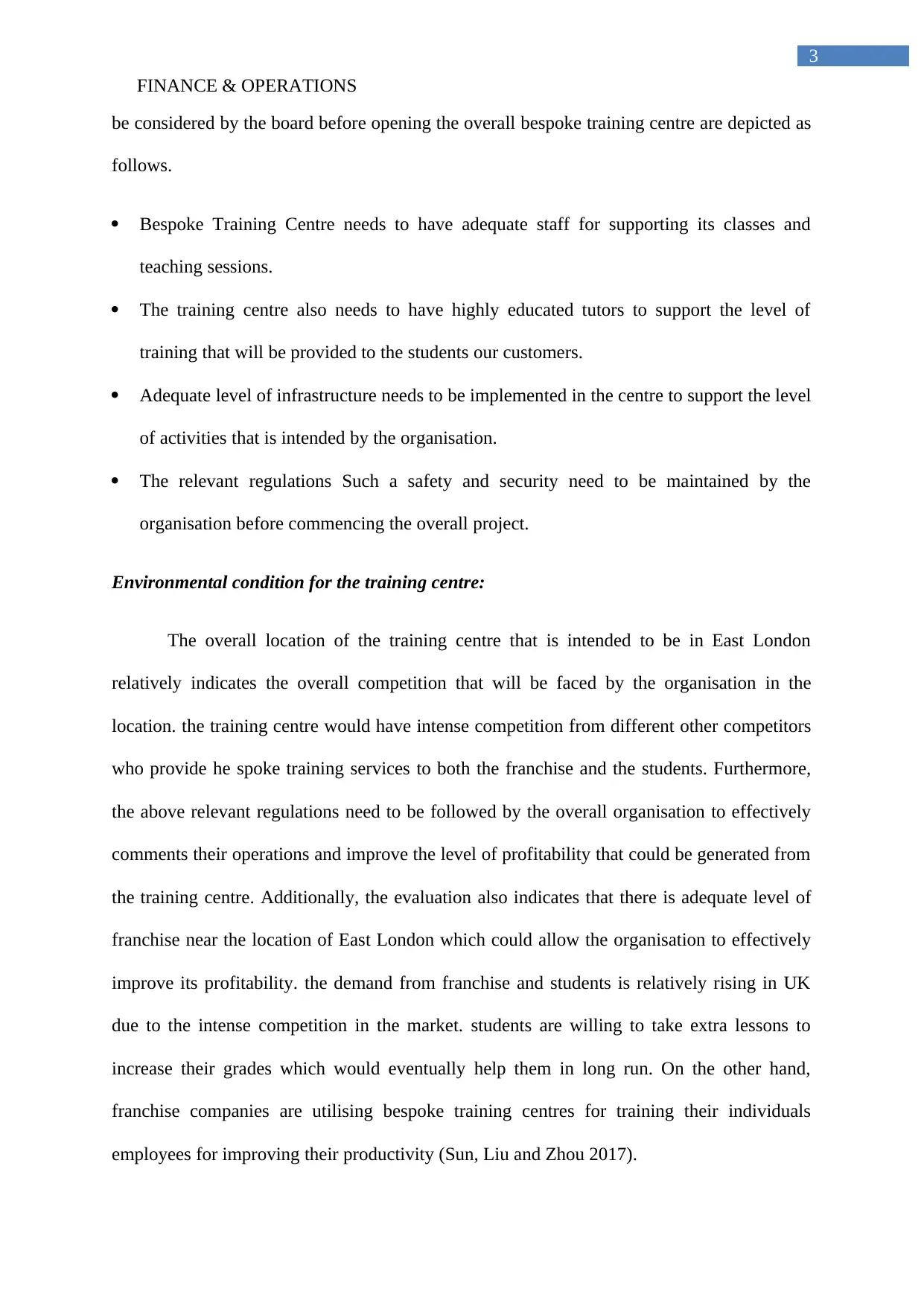
FINANCE & OPERATIONS
3
be considered by the board before opening the overall bespoke training centre are depicted as
follows.
Bespoke Training Centre needs to have adequate staff for supporting its classes and
teaching sessions.
The training centre also needs to have highly educated tutors to support the level of
training that will be provided to the students our customers.
Adequate level of infrastructure needs to be implemented in the centre to support the level
of activities that is intended by the organisation.
The relevant regulations Such a safety and security need to be maintained by the
organisation before commencing the overall project.
Environmental condition for the training centre:
The overall location of the training centre that is intended to be in East London
relatively indicates the overall competition that will be faced by the organisation in the
location. the training centre would have intense competition from different other competitors
who provide he spoke training services to both the franchise and the students. Furthermore,
the above relevant regulations need to be followed by the overall organisation to effectively
comments their operations and improve the level of profitability that could be generated from
the training centre. Additionally, the evaluation also indicates that there is adequate level of
franchise near the location of East London which could allow the organisation to effectively
improve its profitability. the demand from franchise and students is relatively rising in UK
due to the intense competition in the market. students are willing to take extra lessons to
increase their grades which would eventually help them in long run. On the other hand,
franchise companies are utilising bespoke training centres for training their individuals
employees for improving their productivity (Sun, Liu and Zhou 2017).
3
be considered by the board before opening the overall bespoke training centre are depicted as
follows.
Bespoke Training Centre needs to have adequate staff for supporting its classes and
teaching sessions.
The training centre also needs to have highly educated tutors to support the level of
training that will be provided to the students our customers.
Adequate level of infrastructure needs to be implemented in the centre to support the level
of activities that is intended by the organisation.
The relevant regulations Such a safety and security need to be maintained by the
organisation before commencing the overall project.
Environmental condition for the training centre:
The overall location of the training centre that is intended to be in East London
relatively indicates the overall competition that will be faced by the organisation in the
location. the training centre would have intense competition from different other competitors
who provide he spoke training services to both the franchise and the students. Furthermore,
the above relevant regulations need to be followed by the overall organisation to effectively
comments their operations and improve the level of profitability that could be generated from
the training centre. Additionally, the evaluation also indicates that there is adequate level of
franchise near the location of East London which could allow the organisation to effectively
improve its profitability. the demand from franchise and students is relatively rising in UK
due to the intense competition in the market. students are willing to take extra lessons to
increase their grades which would eventually help them in long run. On the other hand,
franchise companies are utilising bespoke training centres for training their individuals
employees for improving their productivity (Sun, Liu and Zhou 2017).
Paraphrase This Document
Need a fresh take? Get an instant paraphrase of this document with our AI Paraphraser
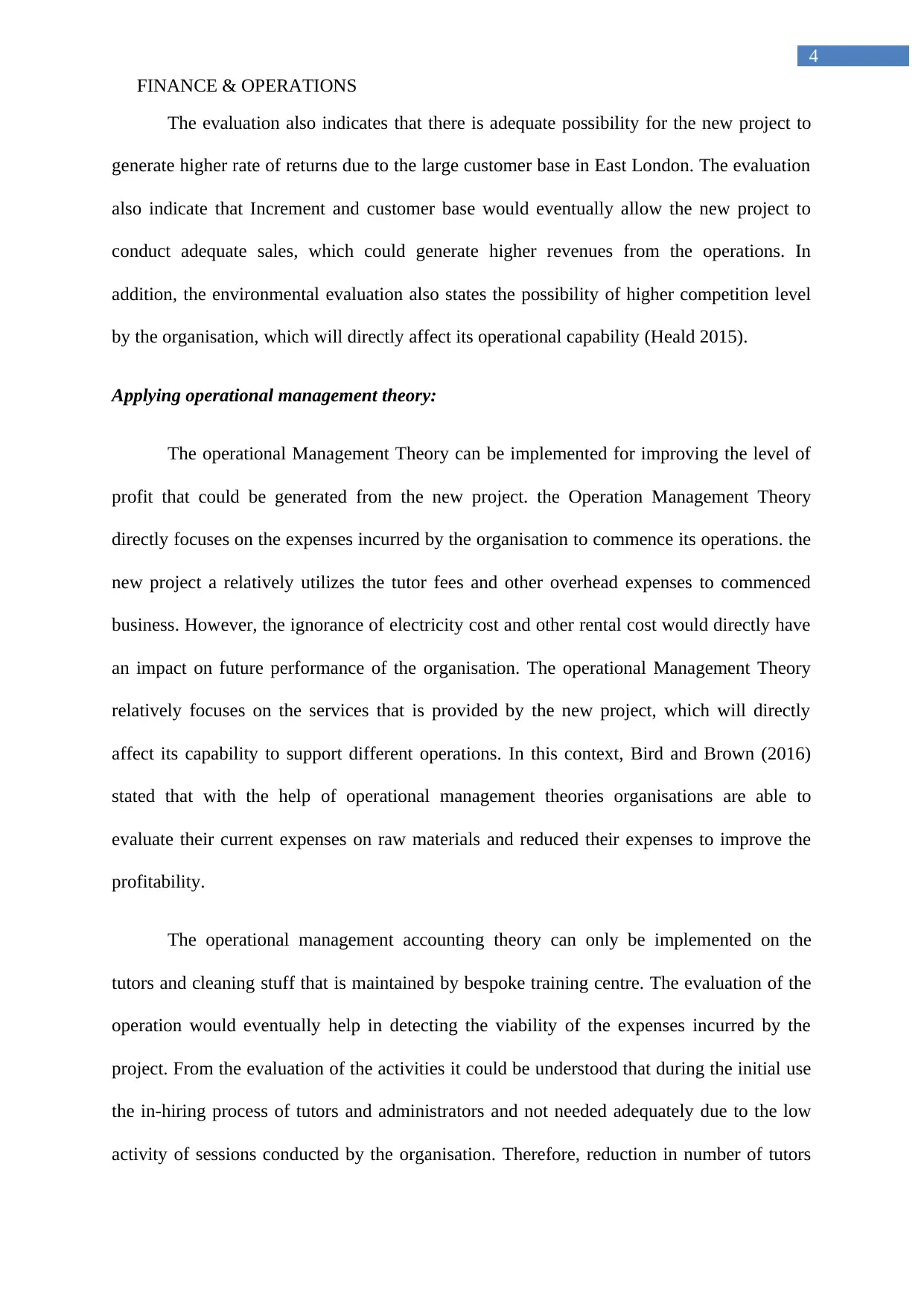
FINANCE & OPERATIONS
4
The evaluation also indicates that there is adequate possibility for the new project to
generate higher rate of returns due to the large customer base in East London. The evaluation
also indicate that Increment and customer base would eventually allow the new project to
conduct adequate sales, which could generate higher revenues from the operations. In
addition, the environmental evaluation also states the possibility of higher competition level
by the organisation, which will directly affect its operational capability (Heald 2015).
Applying operational management theory:
The operational Management Theory can be implemented for improving the level of
profit that could be generated from the new project. the Operation Management Theory
directly focuses on the expenses incurred by the organisation to commence its operations. the
new project a relatively utilizes the tutor fees and other overhead expenses to commenced
business. However, the ignorance of electricity cost and other rental cost would directly have
an impact on future performance of the organisation. The operational Management Theory
relatively focuses on the services that is provided by the new project, which will directly
affect its capability to support different operations. In this context, Bird and Brown (2016)
stated that with the help of operational management theories organisations are able to
evaluate their current expenses on raw materials and reduced their expenses to improve the
profitability.
The operational management accounting theory can only be implemented on the
tutors and cleaning stuff that is maintained by bespoke training centre. The evaluation of the
operation would eventually help in detecting the viability of the expenses incurred by the
project. From the evaluation of the activities it could be understood that during the initial use
the in-hiring process of tutors and administrators and not needed adequately due to the low
activity of sessions conducted by the organisation. Therefore, reduction in number of tutors
4
The evaluation also indicates that there is adequate possibility for the new project to
generate higher rate of returns due to the large customer base in East London. The evaluation
also indicate that Increment and customer base would eventually allow the new project to
conduct adequate sales, which could generate higher revenues from the operations. In
addition, the environmental evaluation also states the possibility of higher competition level
by the organisation, which will directly affect its operational capability (Heald 2015).
Applying operational management theory:
The operational Management Theory can be implemented for improving the level of
profit that could be generated from the new project. the Operation Management Theory
directly focuses on the expenses incurred by the organisation to commence its operations. the
new project a relatively utilizes the tutor fees and other overhead expenses to commenced
business. However, the ignorance of electricity cost and other rental cost would directly have
an impact on future performance of the organisation. The operational Management Theory
relatively focuses on the services that is provided by the new project, which will directly
affect its capability to support different operations. In this context, Bird and Brown (2016)
stated that with the help of operational management theories organisations are able to
evaluate their current expenses on raw materials and reduced their expenses to improve the
profitability.
The operational management accounting theory can only be implemented on the
tutors and cleaning stuff that is maintained by bespoke training centre. The evaluation of the
operation would eventually help in detecting the viability of the expenses incurred by the
project. From the evaluation of the activities it could be understood that during the initial use
the in-hiring process of tutors and administrators and not needed adequately due to the low
activity of sessions conducted by the organisation. Therefore, reduction in number of tutors
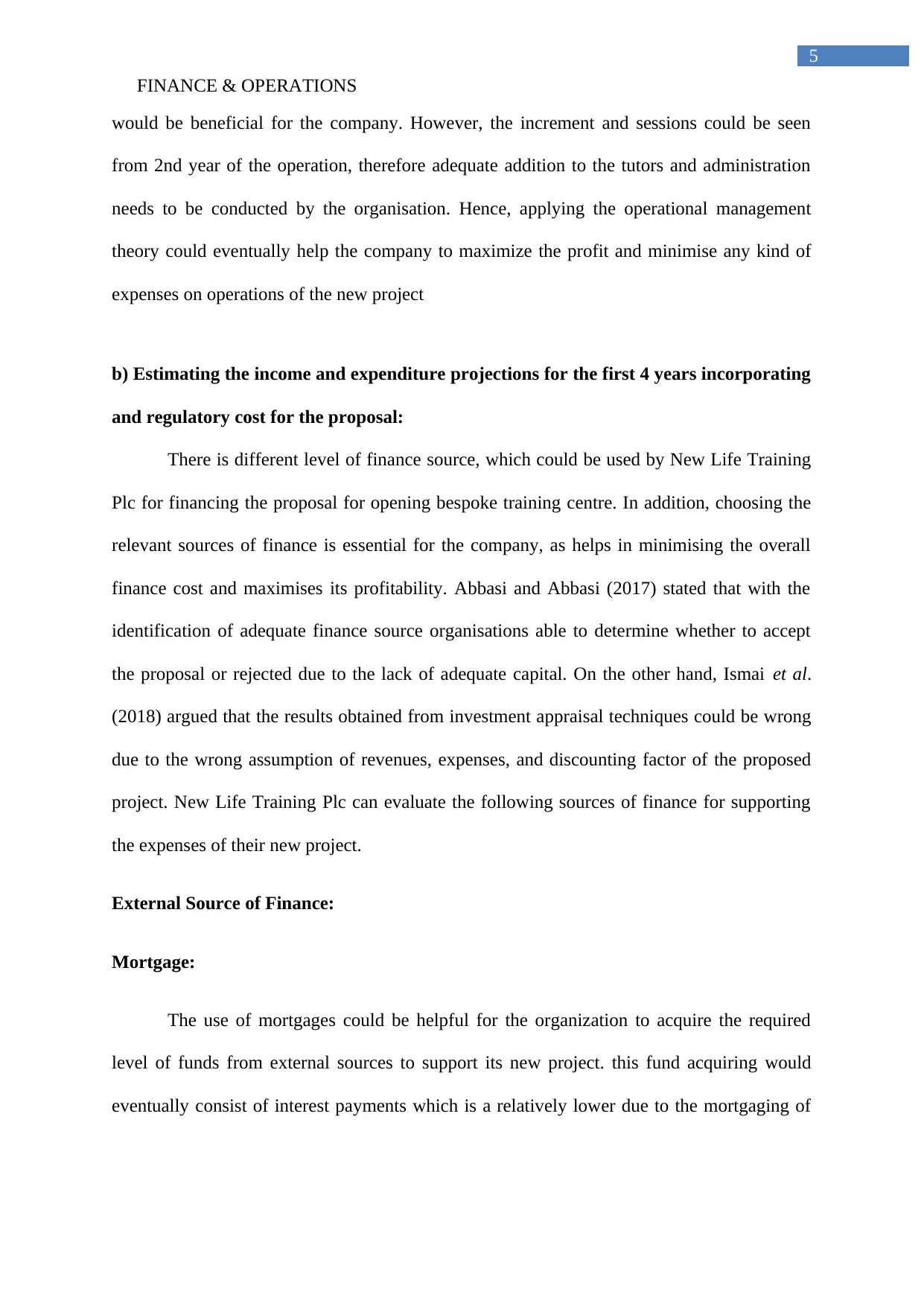
FINANCE & OPERATIONS
5
would be beneficial for the company. However, the increment and sessions could be seen
from 2nd year of the operation, therefore adequate addition to the tutors and administration
needs to be conducted by the organisation. Hence, applying the operational management
theory could eventually help the company to maximize the profit and minimise any kind of
expenses on operations of the new project
b) Estimating the income and expenditure projections for the first 4 years incorporating
and regulatory cost for the proposal:
There is different level of finance source, which could be used by New Life Training
Plc for financing the proposal for opening bespoke training centre. In addition, choosing the
relevant sources of finance is essential for the company, as helps in minimising the overall
finance cost and maximises its profitability. Abbasi and Abbasi (2017) stated that with the
identification of adequate finance source organisations able to determine whether to accept
the proposal or rejected due to the lack of adequate capital. On the other hand, Ismai et al.
(2018) argued that the results obtained from investment appraisal techniques could be wrong
due to the wrong assumption of revenues, expenses, and discounting factor of the proposed
project. New Life Training Plc can evaluate the following sources of finance for supporting
the expenses of their new project.
External Source of Finance:
Mortgage:
The use of mortgages could be helpful for the organization to acquire the required
level of funds from external sources to support its new project. this fund acquiring would
eventually consist of interest payments which is a relatively lower due to the mortgaging of
5
would be beneficial for the company. However, the increment and sessions could be seen
from 2nd year of the operation, therefore adequate addition to the tutors and administration
needs to be conducted by the organisation. Hence, applying the operational management
theory could eventually help the company to maximize the profit and minimise any kind of
expenses on operations of the new project
b) Estimating the income and expenditure projections for the first 4 years incorporating
and regulatory cost for the proposal:
There is different level of finance source, which could be used by New Life Training
Plc for financing the proposal for opening bespoke training centre. In addition, choosing the
relevant sources of finance is essential for the company, as helps in minimising the overall
finance cost and maximises its profitability. Abbasi and Abbasi (2017) stated that with the
identification of adequate finance source organisations able to determine whether to accept
the proposal or rejected due to the lack of adequate capital. On the other hand, Ismai et al.
(2018) argued that the results obtained from investment appraisal techniques could be wrong
due to the wrong assumption of revenues, expenses, and discounting factor of the proposed
project. New Life Training Plc can evaluate the following sources of finance for supporting
the expenses of their new project.
External Source of Finance:
Mortgage:
The use of mortgages could be helpful for the organization to acquire the required
level of funds from external sources to support its new project. this fund acquiring would
eventually consist of interest payments which is a relatively lower due to the mortgaging of
⊘ This is a preview!⊘
Do you want full access?
Subscribe today to unlock all pages.

Trusted by 1+ million students worldwide
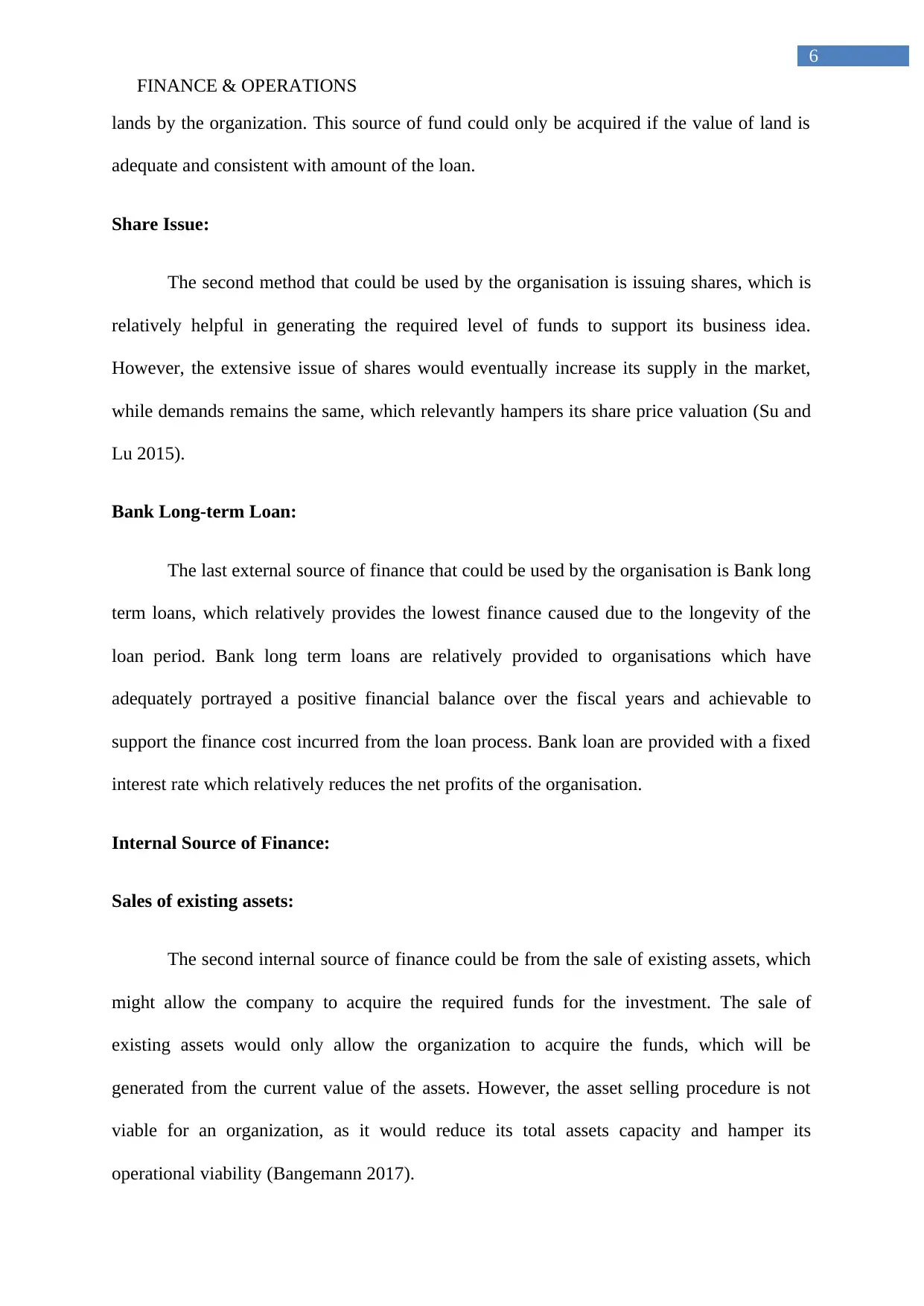
FINANCE & OPERATIONS
6
lands by the organization. This source of fund could only be acquired if the value of land is
adequate and consistent with amount of the loan.
Share Issue:
The second method that could be used by the organisation is issuing shares, which is
relatively helpful in generating the required level of funds to support its business idea.
However, the extensive issue of shares would eventually increase its supply in the market,
while demands remains the same, which relevantly hampers its share price valuation (Su and
Lu 2015).
Bank Long-term Loan:
The last external source of finance that could be used by the organisation is Bank long
term loans, which relatively provides the lowest finance caused due to the longevity of the
loan period. Bank long term loans are relatively provided to organisations which have
adequately portrayed a positive financial balance over the fiscal years and achievable to
support the finance cost incurred from the loan process. Bank loan are provided with a fixed
interest rate which relatively reduces the net profits of the organisation.
Internal Source of Finance:
Sales of existing assets:
The second internal source of finance could be from the sale of existing assets, which
might allow the company to acquire the required funds for the investment. The sale of
existing assets would only allow the organization to acquire the funds, which will be
generated from the current value of the assets. However, the asset selling procedure is not
viable for an organization, as it would reduce its total assets capacity and hamper its
operational viability (Bangemann 2017).
6
lands by the organization. This source of fund could only be acquired if the value of land is
adequate and consistent with amount of the loan.
Share Issue:
The second method that could be used by the organisation is issuing shares, which is
relatively helpful in generating the required level of funds to support its business idea.
However, the extensive issue of shares would eventually increase its supply in the market,
while demands remains the same, which relevantly hampers its share price valuation (Su and
Lu 2015).
Bank Long-term Loan:
The last external source of finance that could be used by the organisation is Bank long
term loans, which relatively provides the lowest finance caused due to the longevity of the
loan period. Bank long term loans are relatively provided to organisations which have
adequately portrayed a positive financial balance over the fiscal years and achievable to
support the finance cost incurred from the loan process. Bank loan are provided with a fixed
interest rate which relatively reduces the net profits of the organisation.
Internal Source of Finance:
Sales of existing assets:
The second internal source of finance could be from the sale of existing assets, which
might allow the company to acquire the required funds for the investment. The sale of
existing assets would only allow the organization to acquire the funds, which will be
generated from the current value of the assets. However, the asset selling procedure is not
viable for an organization, as it would reduce its total assets capacity and hamper its
operational viability (Bangemann 2017).
Paraphrase This Document
Need a fresh take? Get an instant paraphrase of this document with our AI Paraphraser
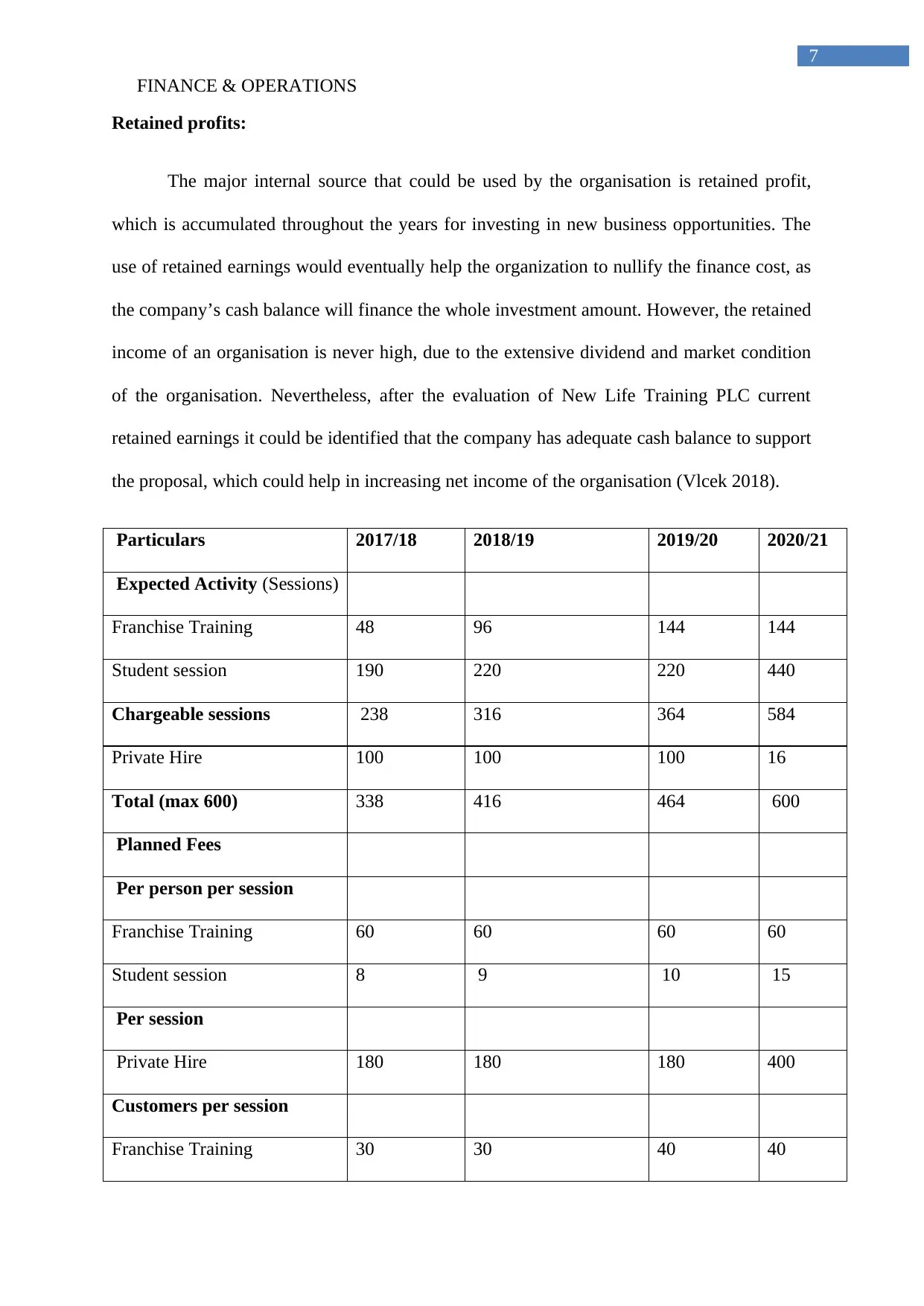
FINANCE & OPERATIONS
7
Retained profits:
The major internal source that could be used by the organisation is retained profit,
which is accumulated throughout the years for investing in new business opportunities. The
use of retained earnings would eventually help the organization to nullify the finance cost, as
the company’s cash balance will finance the whole investment amount. However, the retained
income of an organisation is never high, due to the extensive dividend and market condition
of the organisation. Nevertheless, after the evaluation of New Life Training PLC current
retained earnings it could be identified that the company has adequate cash balance to support
the proposal, which could help in increasing net income of the organisation (Vlcek 2018).
Particulars 2017/18 2018/19 2019/20 2020/21
Expected Activity (Sessions)
Franchise Training 48 96 144 144
Student session 190 220 220 440
Chargeable sessions 238 316 364 584
Private Hire 100 100 100 16
Total (max 600) 338 416 464 600
Planned Fees
Per person per session
Franchise Training 60 60 60 60
Student session 8 9 10 15
Per session
Private Hire 180 180 180 400
Customers per session
Franchise Training 30 30 40 40
7
Retained profits:
The major internal source that could be used by the organisation is retained profit,
which is accumulated throughout the years for investing in new business opportunities. The
use of retained earnings would eventually help the organization to nullify the finance cost, as
the company’s cash balance will finance the whole investment amount. However, the retained
income of an organisation is never high, due to the extensive dividend and market condition
of the organisation. Nevertheless, after the evaluation of New Life Training PLC current
retained earnings it could be identified that the company has adequate cash balance to support
the proposal, which could help in increasing net income of the organisation (Vlcek 2018).
Particulars 2017/18 2018/19 2019/20 2020/21
Expected Activity (Sessions)
Franchise Training 48 96 144 144
Student session 190 220 220 440
Chargeable sessions 238 316 364 584
Private Hire 100 100 100 16
Total (max 600) 338 416 464 600
Planned Fees
Per person per session
Franchise Training 60 60 60 60
Student session 8 9 10 15
Per session
Private Hire 180 180 180 400
Customers per session
Franchise Training 30 30 40 40
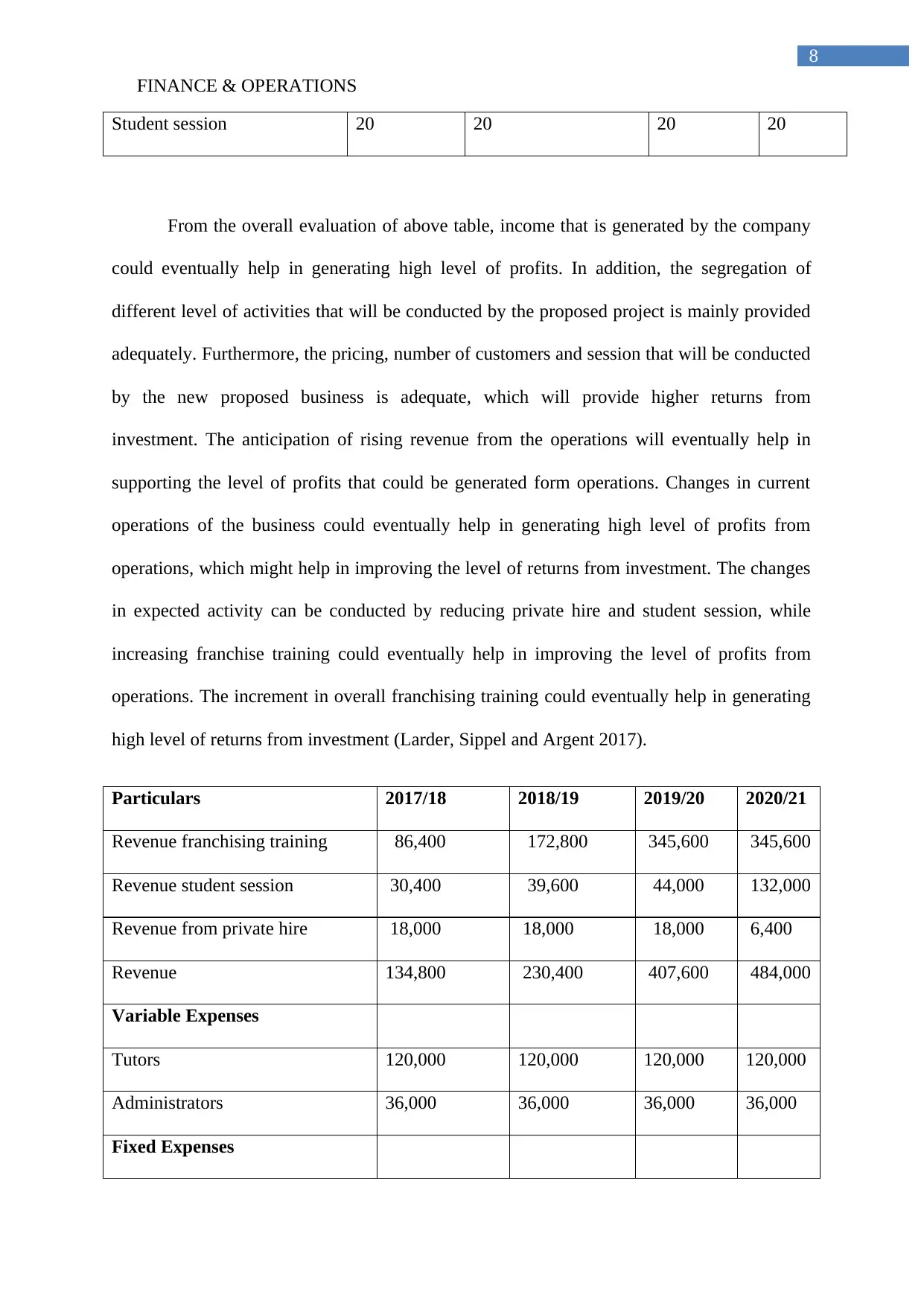
FINANCE & OPERATIONS
8
Student session 20 20 20 20
From the overall evaluation of above table, income that is generated by the company
could eventually help in generating high level of profits. In addition, the segregation of
different level of activities that will be conducted by the proposed project is mainly provided
adequately. Furthermore, the pricing, number of customers and session that will be conducted
by the new proposed business is adequate, which will provide higher returns from
investment. The anticipation of rising revenue from the operations will eventually help in
supporting the level of profits that could be generated form operations. Changes in current
operations of the business could eventually help in generating high level of profits from
operations, which might help in improving the level of returns from investment. The changes
in expected activity can be conducted by reducing private hire and student session, while
increasing franchise training could eventually help in improving the level of profits from
operations. The increment in overall franchising training could eventually help in generating
high level of returns from investment (Larder, Sippel and Argent 2017).
Particulars 2017/18 2018/19 2019/20 2020/21
Revenue franchising training 86,400 172,800 345,600 345,600
Revenue student session 30,400 39,600 44,000 132,000
Revenue from private hire 18,000 18,000 18,000 6,400
Revenue 134,800 230,400 407,600 484,000
Variable Expenses
Tutors 120,000 120,000 120,000 120,000
Administrators 36,000 36,000 36,000 36,000
Fixed Expenses
8
Student session 20 20 20 20
From the overall evaluation of above table, income that is generated by the company
could eventually help in generating high level of profits. In addition, the segregation of
different level of activities that will be conducted by the proposed project is mainly provided
adequately. Furthermore, the pricing, number of customers and session that will be conducted
by the new proposed business is adequate, which will provide higher returns from
investment. The anticipation of rising revenue from the operations will eventually help in
supporting the level of profits that could be generated form operations. Changes in current
operations of the business could eventually help in generating high level of profits from
operations, which might help in improving the level of returns from investment. The changes
in expected activity can be conducted by reducing private hire and student session, while
increasing franchise training could eventually help in improving the level of profits from
operations. The increment in overall franchising training could eventually help in generating
high level of returns from investment (Larder, Sippel and Argent 2017).
Particulars 2017/18 2018/19 2019/20 2020/21
Revenue franchising training 86,400 172,800 345,600 345,600
Revenue student session 30,400 39,600 44,000 132,000
Revenue from private hire 18,000 18,000 18,000 6,400
Revenue 134,800 230,400 407,600 484,000
Variable Expenses
Tutors 120,000 120,000 120,000 120,000
Administrators 36,000 36,000 36,000 36,000
Fixed Expenses
⊘ This is a preview!⊘
Do you want full access?
Subscribe today to unlock all pages.

Trusted by 1+ million students worldwide
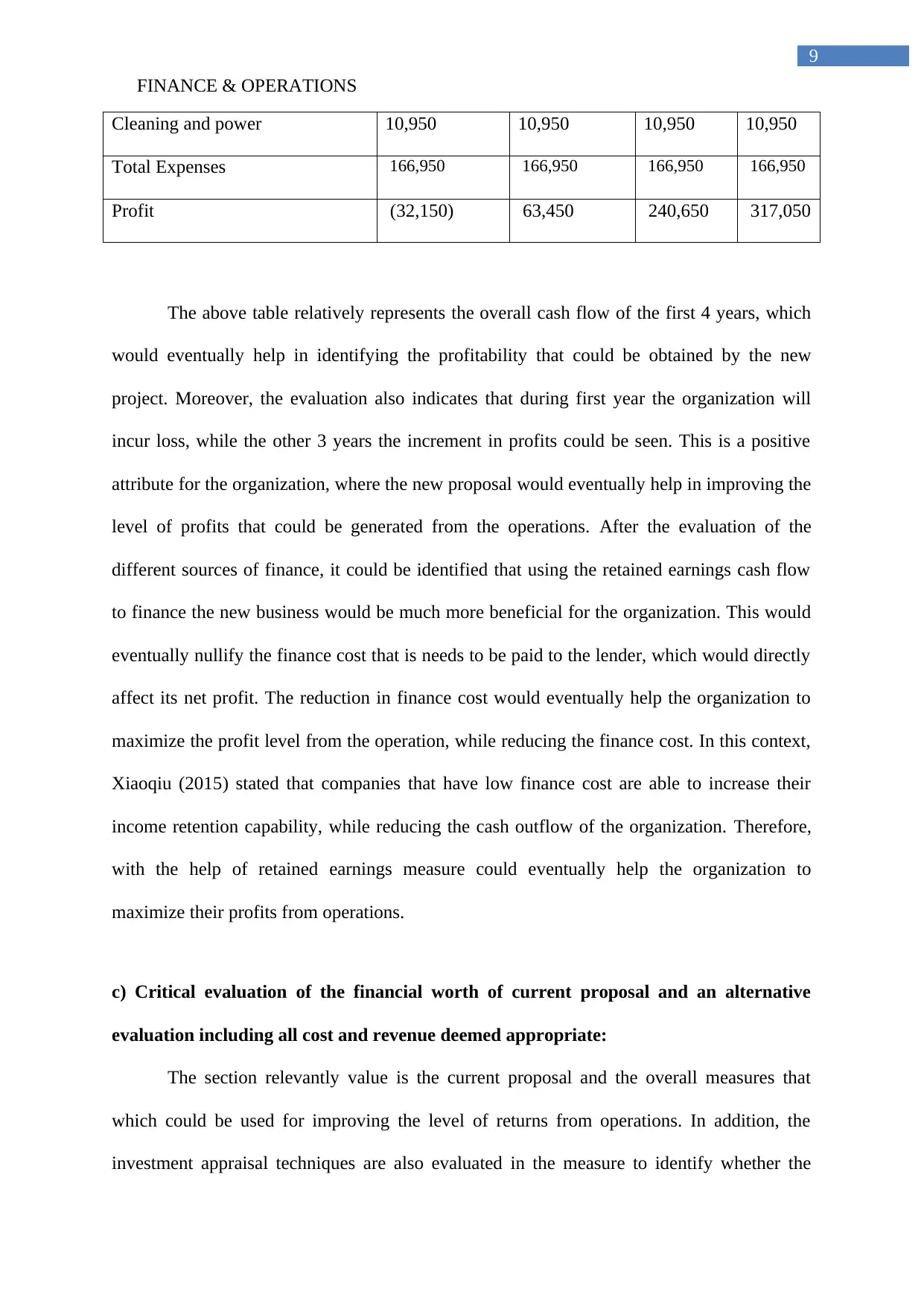
FINANCE & OPERATIONS
9
Cleaning and power 10,950 10,950 10,950 10,950
Total Expenses 166,950 166,950 166,950 166,950
Profit (32,150) 63,450 240,650 317,050
The above table relatively represents the overall cash flow of the first 4 years, which
would eventually help in identifying the profitability that could be obtained by the new
project. Moreover, the evaluation also indicates that during first year the organization will
incur loss, while the other 3 years the increment in profits could be seen. This is a positive
attribute for the organization, where the new proposal would eventually help in improving the
level of profits that could be generated from the operations. After the evaluation of the
different sources of finance, it could be identified that using the retained earnings cash flow
to finance the new business would be much more beneficial for the organization. This would
eventually nullify the finance cost that is needs to be paid to the lender, which would directly
affect its net profit. The reduction in finance cost would eventually help the organization to
maximize the profit level from the operation, while reducing the finance cost. In this context,
Xiaoqiu (2015) stated that companies that have low finance cost are able to increase their
income retention capability, while reducing the cash outflow of the organization. Therefore,
with the help of retained earnings measure could eventually help the organization to
maximize their profits from operations.
c) Critical evaluation of the financial worth of current proposal and an alternative
evaluation including all cost and revenue deemed appropriate:
The section relevantly value is the current proposal and the overall measures that
which could be used for improving the level of returns from operations. In addition, the
investment appraisal techniques are also evaluated in the measure to identify whether the
9
Cleaning and power 10,950 10,950 10,950 10,950
Total Expenses 166,950 166,950 166,950 166,950
Profit (32,150) 63,450 240,650 317,050
The above table relatively represents the overall cash flow of the first 4 years, which
would eventually help in identifying the profitability that could be obtained by the new
project. Moreover, the evaluation also indicates that during first year the organization will
incur loss, while the other 3 years the increment in profits could be seen. This is a positive
attribute for the organization, where the new proposal would eventually help in improving the
level of profits that could be generated from the operations. After the evaluation of the
different sources of finance, it could be identified that using the retained earnings cash flow
to finance the new business would be much more beneficial for the organization. This would
eventually nullify the finance cost that is needs to be paid to the lender, which would directly
affect its net profit. The reduction in finance cost would eventually help the organization to
maximize the profit level from the operation, while reducing the finance cost. In this context,
Xiaoqiu (2015) stated that companies that have low finance cost are able to increase their
income retention capability, while reducing the cash outflow of the organization. Therefore,
with the help of retained earnings measure could eventually help the organization to
maximize their profits from operations.
c) Critical evaluation of the financial worth of current proposal and an alternative
evaluation including all cost and revenue deemed appropriate:
The section relevantly value is the current proposal and the overall measures that
which could be used for improving the level of returns from operations. In addition, the
investment appraisal techniques are also evaluated in the measure to identify whether the
Paraphrase This Document
Need a fresh take? Get an instant paraphrase of this document with our AI Paraphraser
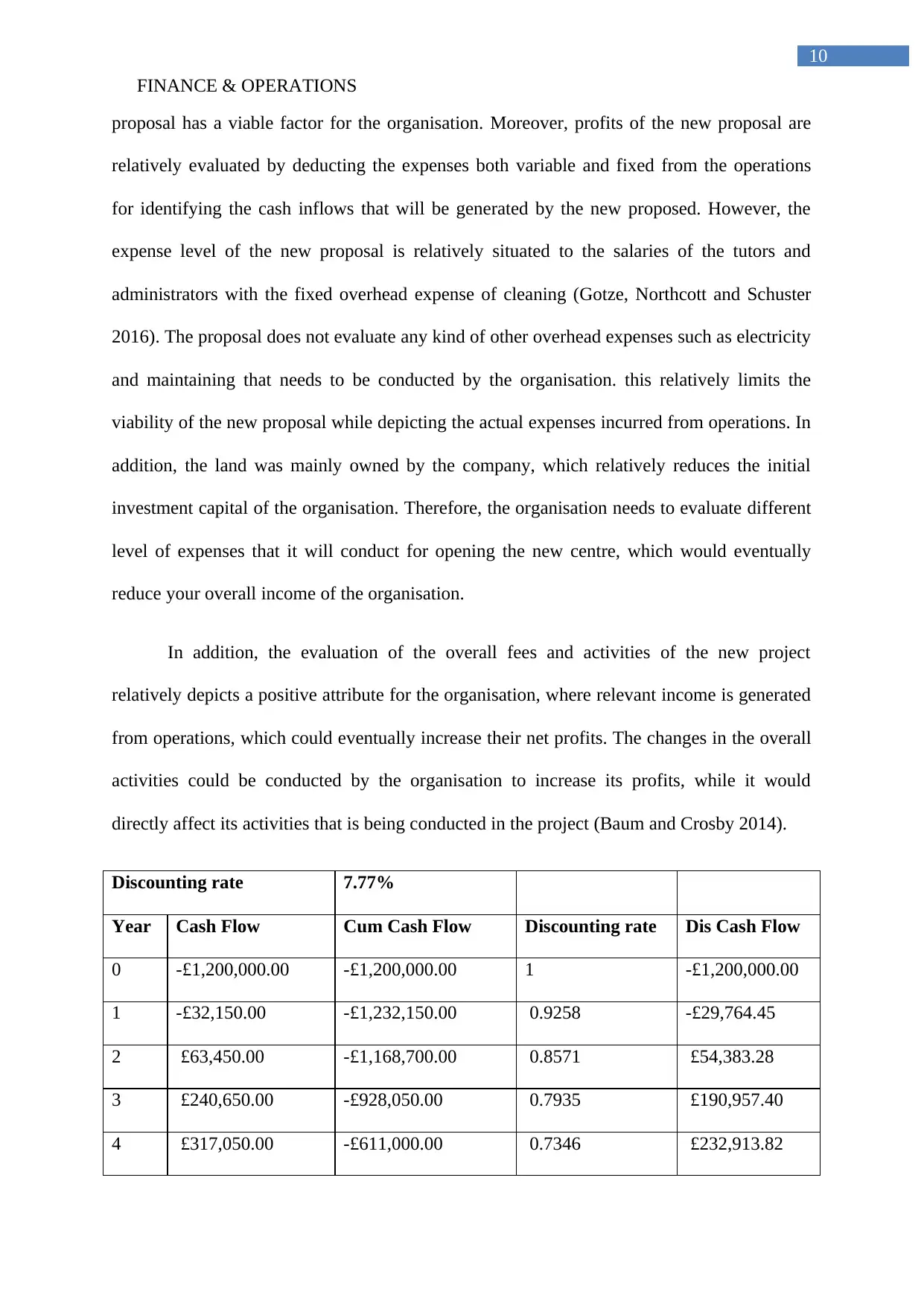
FINANCE & OPERATIONS
10
proposal has a viable factor for the organisation. Moreover, profits of the new proposal are
relatively evaluated by deducting the expenses both variable and fixed from the operations
for identifying the cash inflows that will be generated by the new proposed. However, the
expense level of the new proposal is relatively situated to the salaries of the tutors and
administrators with the fixed overhead expense of cleaning (Gotze, Northcott and Schuster
2016). The proposal does not evaluate any kind of other overhead expenses such as electricity
and maintaining that needs to be conducted by the organisation. this relatively limits the
viability of the new proposal while depicting the actual expenses incurred from operations. In
addition, the land was mainly owned by the company, which relatively reduces the initial
investment capital of the organisation. Therefore, the organisation needs to evaluate different
level of expenses that it will conduct for opening the new centre, which would eventually
reduce your overall income of the organisation.
In addition, the evaluation of the overall fees and activities of the new project
relatively depicts a positive attribute for the organisation, where relevant income is generated
from operations, which could eventually increase their net profits. The changes in the overall
activities could be conducted by the organisation to increase its profits, while it would
directly affect its activities that is being conducted in the project (Baum and Crosby 2014).
Discounting rate 7.77%
Year Cash Flow Cum Cash Flow Discounting rate Dis Cash Flow
0 -£1,200,000.00 -£1,200,000.00 1 -£1,200,000.00
1 -£32,150.00 -£1,232,150.00 0.9258 -£29,764.45
2 £63,450.00 -£1,168,700.00 0.8571 £54,383.28
3 £240,650.00 -£928,050.00 0.7935 £190,957.40
4 £317,050.00 -£611,000.00 0.7346 £232,913.82
10
proposal has a viable factor for the organisation. Moreover, profits of the new proposal are
relatively evaluated by deducting the expenses both variable and fixed from the operations
for identifying the cash inflows that will be generated by the new proposed. However, the
expense level of the new proposal is relatively situated to the salaries of the tutors and
administrators with the fixed overhead expense of cleaning (Gotze, Northcott and Schuster
2016). The proposal does not evaluate any kind of other overhead expenses such as electricity
and maintaining that needs to be conducted by the organisation. this relatively limits the
viability of the new proposal while depicting the actual expenses incurred from operations. In
addition, the land was mainly owned by the company, which relatively reduces the initial
investment capital of the organisation. Therefore, the organisation needs to evaluate different
level of expenses that it will conduct for opening the new centre, which would eventually
reduce your overall income of the organisation.
In addition, the evaluation of the overall fees and activities of the new project
relatively depicts a positive attribute for the organisation, where relevant income is generated
from operations, which could eventually increase their net profits. The changes in the overall
activities could be conducted by the organisation to increase its profits, while it would
directly affect its activities that is being conducted in the project (Baum and Crosby 2014).
Discounting rate 7.77%
Year Cash Flow Cum Cash Flow Discounting rate Dis Cash Flow
0 -£1,200,000.00 -£1,200,000.00 1 -£1,200,000.00
1 -£32,150.00 -£1,232,150.00 0.9258 -£29,764.45
2 £63,450.00 -£1,168,700.00 0.8571 £54,383.28
3 £240,650.00 -£928,050.00 0.7935 £190,957.40
4 £317,050.00 -£611,000.00 0.7346 £232,913.82
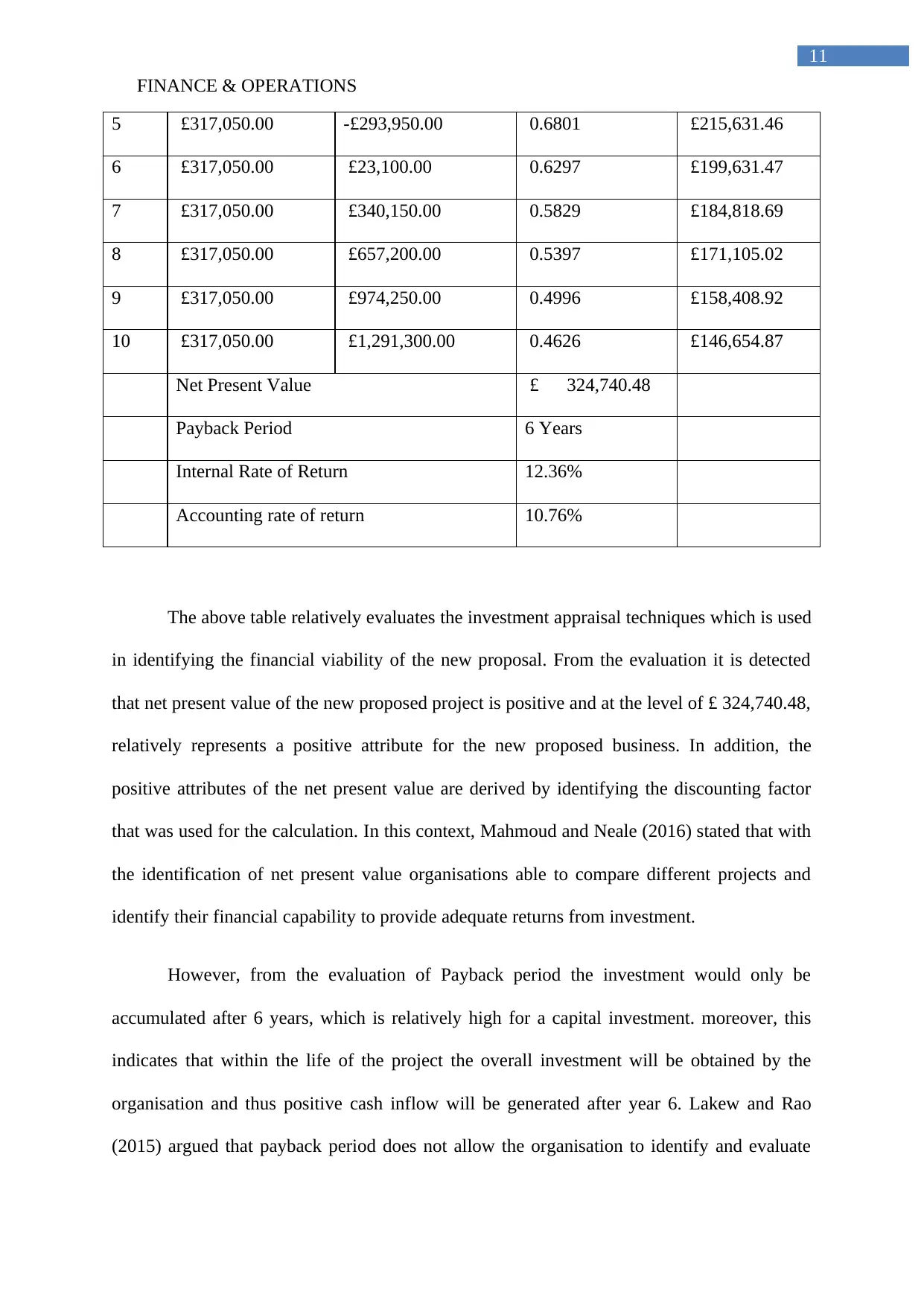
FINANCE & OPERATIONS
11
5 £317,050.00 -£293,950.00 0.6801 £215,631.46
6 £317,050.00 £23,100.00 0.6297 £199,631.47
7 £317,050.00 £340,150.00 0.5829 £184,818.69
8 £317,050.00 £657,200.00 0.5397 £171,105.02
9 £317,050.00 £974,250.00 0.4996 £158,408.92
10 £317,050.00 £1,291,300.00 0.4626 £146,654.87
Net Present Value £ 324,740.48
Payback Period 6 Years
Internal Rate of Return 12.36%
Accounting rate of return 10.76%
The above table relatively evaluates the investment appraisal techniques which is used
in identifying the financial viability of the new proposal. From the evaluation it is detected
that net present value of the new proposed project is positive and at the level of £ 324,740.48,
relatively represents a positive attribute for the new proposed business. In addition, the
positive attributes of the net present value are derived by identifying the discounting factor
that was used for the calculation. In this context, Mahmoud and Neale (2016) stated that with
the identification of net present value organisations able to compare different projects and
identify their financial capability to provide adequate returns from investment.
However, from the evaluation of Payback period the investment would only be
accumulated after 6 years, which is relatively high for a capital investment. moreover, this
indicates that within the life of the project the overall investment will be obtained by the
organisation and thus positive cash inflow will be generated after year 6. Lakew and Rao
(2015) argued that payback period does not allow the organisation to identify and evaluate
11
5 £317,050.00 -£293,950.00 0.6801 £215,631.46
6 £317,050.00 £23,100.00 0.6297 £199,631.47
7 £317,050.00 £340,150.00 0.5829 £184,818.69
8 £317,050.00 £657,200.00 0.5397 £171,105.02
9 £317,050.00 £974,250.00 0.4996 £158,408.92
10 £317,050.00 £1,291,300.00 0.4626 £146,654.87
Net Present Value £ 324,740.48
Payback Period 6 Years
Internal Rate of Return 12.36%
Accounting rate of return 10.76%
The above table relatively evaluates the investment appraisal techniques which is used
in identifying the financial viability of the new proposal. From the evaluation it is detected
that net present value of the new proposed project is positive and at the level of £ 324,740.48,
relatively represents a positive attribute for the new proposed business. In addition, the
positive attributes of the net present value are derived by identifying the discounting factor
that was used for the calculation. In this context, Mahmoud and Neale (2016) stated that with
the identification of net present value organisations able to compare different projects and
identify their financial capability to provide adequate returns from investment.
However, from the evaluation of Payback period the investment would only be
accumulated after 6 years, which is relatively high for a capital investment. moreover, this
indicates that within the life of the project the overall investment will be obtained by the
organisation and thus positive cash inflow will be generated after year 6. Lakew and Rao
(2015) argued that payback period does not allow the organisation to identify and evaluate
⊘ This is a preview!⊘
Do you want full access?
Subscribe today to unlock all pages.

Trusted by 1+ million students worldwide
1 out of 20
Related Documents
Your All-in-One AI-Powered Toolkit for Academic Success.
+13062052269
info@desklib.com
Available 24*7 on WhatsApp / Email
![[object Object]](/_next/static/media/star-bottom.7253800d.svg)
Unlock your academic potential
Copyright © 2020–2025 A2Z Services. All Rights Reserved. Developed and managed by ZUCOL.





